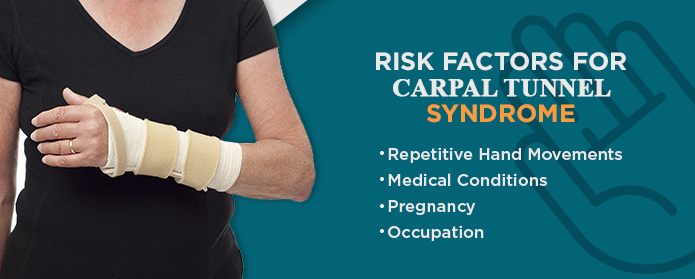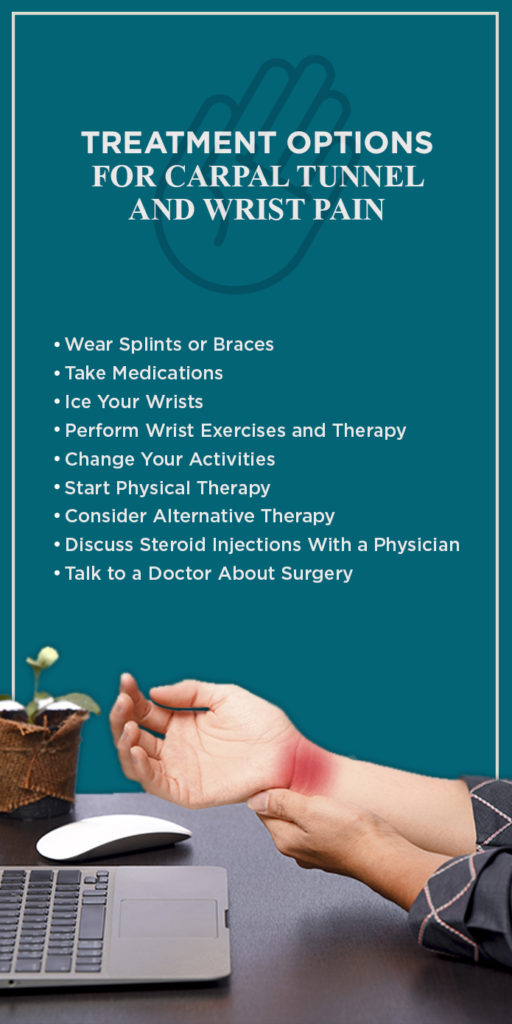Are you noticing a numb, weak, pins-and-needles or falling asleep sensation in your hand and wrist? What about pain in your wrist? Perhaps, all of these sensations are occurring for no apparent reason. If you’re having these symptoms, chances are you could be experiencing carpal tunnel syndrome.
It’s best not to delay carpal tunnel treatment or wrist pain treatment, as ignoring the symptoms of this common condition could lead to permanent nerve damage. If you suspect you have carpal tunnel syndrome (CTS), visit us at the Orthopedic Institute of Pennsylvania (OIP) to receive an official diagnosis and begin treatment.
What Is Carpal Tunnel Syndrome?

Carpal tunnel syndrome is a relatively common condition affecting your wrist and hand. It’s estimated to affect up to 6 percent of people in the U.S., particularly in the 45 to 64 age group. Since the narrow passageway on the palm side of the wrist, known as the carpal tunnel, is often smaller in women than men, women are three times more predisposed to the condition than their male counterparts.
Your symptoms may begin in a mild form initially, but as the condition progresses, you can find CTS becomes more bothersome and painful. You may first notice numbness or tingling in your fingers off and on. But, the sensations can become worse over time, last longer and even wake you up at night. Eventually, the numbness and pain could make it difficult to grips things like a pen, fork or another object.
This condition occurs when your median nerve — the nerve passing through the carpal tunnel, or narrow space that runs to your hand from your forearm — is pinched or compressed. The median nerve controls the movement and sensations in the pointer, middle and ring fingers, as well as the thumb. You usually experience it in your dominant hand first, which is typically where you will feel the most severe pain.
Risk Factors for Carpal Tunnel Syndrome

Anything that makes your carpal tunnel smaller, pinching the median nerve, may lead to carpal tunnel syndrome. These may include:
- Repetitive Hand Movements: Although repetitive activities like typing on the keyboard were thought to induce carpal tunnel syndrome, research now shows this isn’t the most prominent cause. Regular use of vibrating or heavy equipment, such as a jackhammer, can predispose you to carpal tunnel syndrome. You’re also more likely to develop CTS if you regularly bend your wrist at a higher level than your hands.
- Medical Conditions: Certain medical conditions can cause carpal tunnel syndrome, such as rheumatoid arthritis, hypothyroidism and diabetes. For instance, people who have diabetes and other metabolic disorders that affect the nerves of the body are more vulnerable to compression, so they have a higher risk of developing CTS, according to the National Institute of Neurological Disorders and Stroke (NINDS). Children do not usually experience carpal tunnel syndrome.
- Pregnancy: If you have edema, or a build-up of fluid in your wrist tissues during pregnancy, you can develop carpal tunnel syndrome. CTS typically disappears shortly after giving birth.
- Occupation: The chances of developing carpal tunnel syndrome aren’t confined to individuals in a single job or industry, but it’s particularly common in people who perform assembly line work like cleaning, packing or manufacturing. In fact, assemblers are three times more likely to develop carpal tunnel syndrome than data entry personnel.
Treatment Options for Carpal Tunnel and Wrist Pain

Here are nine potential treatment options for carpal tunnel — although it’s always smart to see a doctor to determine the best method for you.
1. Wear Splints or Braces
You can help relieve median nerve pressure by keeping your wrists straight. Individuals often experience symptoms more at night. If this is the case for you, wearing a splint during the evening can help alleviate your symptoms before they begin. You may also wear a splint brace during the day if you have problems at work with repetitive tasks.
Braces are typically best when you’re experiencing mild to moderate symptoms of carpal tunnel syndrome. While they might not work for everyone, it doesn’t hurt to try one since no adverse side effects are involved. Give it a few weeks to see if your symptoms improve.
The doctor will likely recommend you wear a brace during the night when you’re in bed. This is because many individuals bend their wrists while sleeping and this can worsen the symptoms.
2. Take Medications
Several types of medications serve as treatment options for wrist pain, including:
- Over-the-Counter (OTC) Medications: In some cases, drugs can help ease the swelling and pain linked with carpal tunnel syndrome. For instance, nonsteroidal anti-inflammatory drugs (NSAIDs) like ibuprofen and aspirin might offer you short-term relief from pain and discomfort, but they don’t treat the condition.
- Topicals: One study showed slaughterhouse workers with carpal tunnel syndrome who applied topical menthol during the workday significantly reduced their pain. If you would like to try a topical, consult with your doctor and be sure to follow the directions on the package.
3. Ice Your Wrists
Soak or ice your wrist in an ice bath for around 15 minutes once or a couple of times an hour. Icing may help relieve the pain.
4. Perform Wrist Exercises and Therapy
Here are a few wrist exercises you can try to relieve pain:
- Shake It Out: Once an hour for one or two minutes, shake your hands as if you’re trying to air dry them after washing them. By doing this, you’re helping to keep your hand flexor muscles and the median nerve from becoming tight and cramped during the day. You may already be doing this just by washing your hands frequently throughout the day.
- Wrist Flex and Extend: For this exercise, you’ll hold your arm in front of you straight out, keeping your hand and wrist straight and palm facing down. Start bending your wrist down, so you’re pointing your fingers toward the floor. Using your other hand, start pulling your fingers gently toward your body to help increase the stretch. Hold this position for up to 30 seconds. Now, return to a neutral, straight wrist position with palm still facing down. Begin bending your wrist up, so you’re pointing your fingertips toward the ceiling. Gently pull your fingers with the other hand back toward you, holding the position for another 30 seconds. Repeat 10 times a few times a day.
- Stretch It Out: Whether you’re sitting at your desk or standing in line at your local grocery store, you can perform this simple and quick wrist exercise. Make a fist and release, so your fingers are straight again. Continue performing this exercise up to 10 times to help relieve any pressure you may have in your wrist.
5. Change Your Activities
Often, carpal tunnel syndrome will flare up when you have been holding your wrist and hand in the same position for a long time. Keeping your wrist bent up or down can make it even worse — therefore, you should try to maintain a neutral, straight position the best you can. If your work makes this difficult, you might want to:
- Lighten Up: If you’re finding you are forcing or straining with tasks like typing or writing, reduce the force you’re using or relax your grip. Try tapping the keys a little lighter or use a soft-grip pen.
- Take a Break From Repetitive Tasks: Whether you’re using a hand drill, playing a guitar or typing, set a timer for 15 minutes before you start. Once it goes off, it’s time to take a break and wiggle your fingers. Move your wrists and stretch your hands to improve blood flow in these areas.
- Be Aware of Your Flexion: Avoid performing activities that cause you to flex your wrists in either direction to the extreme. Try to keep your wrists in a neutral position as much as you can.
- Keep Your Hands Warm: You can ease stiffness and pain by keeping your hands warm. Consider keeping hand warmers close or wearing fingerless gloves. Or, soak your hand in water that’s between 92 and 100 degrees, gently flexing your wrist and moving your hand. Repeat this several times a day.
- Use Only as Much Force as Required: Don’t pound away on your keyboard or hold your tools too tightly.
- Elevate Your Wrists and Hands Whenever You Can: This could be especially beneficial if fractures, pregnancy or fluid retention caused your carpal tunnel syndrome.
- Improve Your Posture: Don’t roll your shoulders forward, as this can set off a chain reaction and worsen the problems with your wrist.
6. Start Physical Therapy
A physical or occupational therapist can help in several ways. They might provide you with exercises for stretching and strengthening your wrist and hand muscles. They may also show you how to make changes to your regular motions in a way that eases the stress from your wrists and hands. These exercises could be particularly helpful when you’re performing activities related to your favorite hobbies or work.
7. Consider Alternative Therapy
Incorporate alternative therapies into your plan to help you manage your carpal tunnel syndrome. You may need to experiment with a few options to determine which treatment will work best for you. Always consult with your doctor before you try any alternative or complementary therapy.
As you try to figure out how to relieve wrist pain, you can test out these alternative therapies:
- Yoga: Yoga postures intended for stretching, strengthening and balancing your joints and upper body can help you decrease your pain and improve your grip strength.
- Acupuncture: Acupuncture is an excellent solution for many because it is low-risk and minimally invasive. In one study published in the journal Brain, researchers concluded that acupuncture helped to relieve pain for individuals with carpal tunnel syndrome. According to the researchers, the acupuncture “remapped” the brain, helping to reduce symptoms. They also said acupuncture provides direct healing effects to the source of the pain in the individual’s wrists. High-tech imaging showed acupuncture led to some mapping changes in the brain. Additionally, participants seemed to experience some healing effects in their wrists.
- Hand Therapy: Research shows certain occupational and physical hand therapy methods could reduce carpal tunnel syndrome symptoms.
- Ultrasound Therapy: High-intensity ultrasounds may help to raise the targeted body tissue area’s temperature to decrease pain and encourage healing. The research found varying results with this treatment, but an ultrasound therapy course over a few weeks could help decrease symptoms.
8. Discuss Steroid Injections With a Physician
Your physician might provide a corticosteroid, like a cortisone injection, to your carpal tunnel to relieve pain. In some cases, your doctor might use ultrasound for guiding these injections. Corticosteroids reduce swelling and inflammation, helping to relieve pressure on your median nerve.
9. Talk to a Doctor About Surgery
Typically, surgery will involve severing a ligament around your wrist to help reduce median nerve pressure. Surgery is generally performed under regional — involving some sedation — or local anesthesia and doesn’t require an overnight stay at the hospital. Many individuals need surgery on both hands.
Although carpal tunnel surgery involves the surgeon relieving nerve pressure by cutting the ligament, they can use two different methods to accomplish this:
- Open Release Surgery: Open release surgery is the standard surgery used for correcting carpal tunnel syndrome. The surgeon makes a two-inch incision in your wrist and cuts the carpal ligament so they can enlarge the carpal tunnel. Usually, patients require local anesthesia for this surgery, and it’s performed on an outpatient basis.
- Endoscopic Surgery: Endoscopic surgery may allow for less post-operative discomfort and quicker functional recovery than the standard open release surgery. There could, however, be more complications, and you may require additional surgery. The surgeon will make an incision — or two — of around a half an inch in your palm and wrist. Then, they’ll insert a camera which is attached to a tube so they can observe the ligament, nerve and tendons while cutting the carpal ligament.
After surgery, the ligaments will typically grow back together, allowing more space than before. While surgery may help relieve symptoms immediately after the procedure, full recovery can take several months. Usually, patients notice a decrease in their grip strength, but this improves over time. Some people might develop nerve damage, infections, pain and stiffness at the scar.
Call Orthopedic Institute of Pennsylvania to Set Up Your Carpal Tunnel and Wrist Pain Appointment

Carpal tunnel syndrome can be disruptive to your everyday life and painful. If you’re experiencing carpal tunnel syndrome symptoms, make an appointment with a doctor to receive an official diagnosis and relieve the pressure and pain you’re experiencing. Receiving an early diagnosis and treatment can help you prevent permanent nerve damage.
Orthopedic Institute of Pennsylvania is based in central Pennsylvania and committed to providing quality care and treatment to our patients. Contact us whether you recently started experiencing pain or have been for some time. We can provide you with holistic treatment options to help you get back to your pain-free life.
Most of our providers are specialists who can provide you with specialized care. We offer numerous treatments and services and are pleased to say 95 percent of our patients didn’t require orthopedic surgery to alleviate their problems. Schedule an appointment at any one of our eight locations to start treating your carpal tunnel syndrome today.


